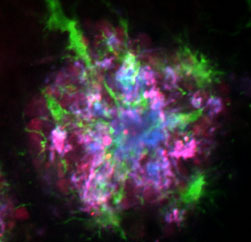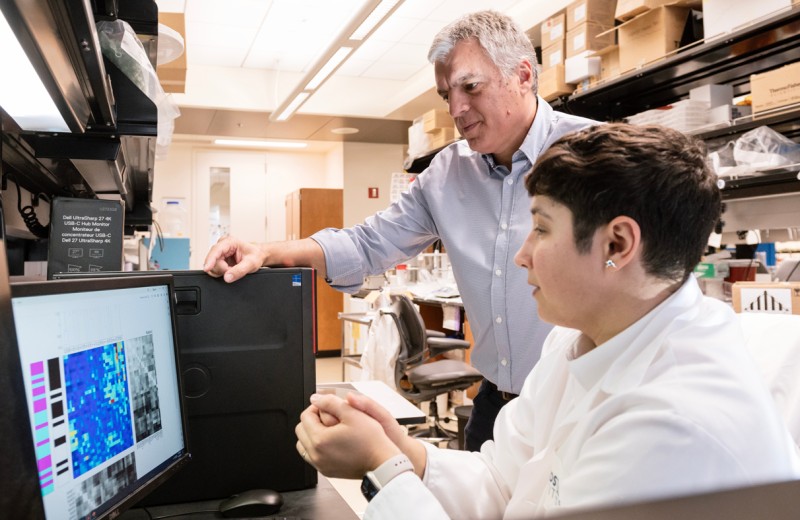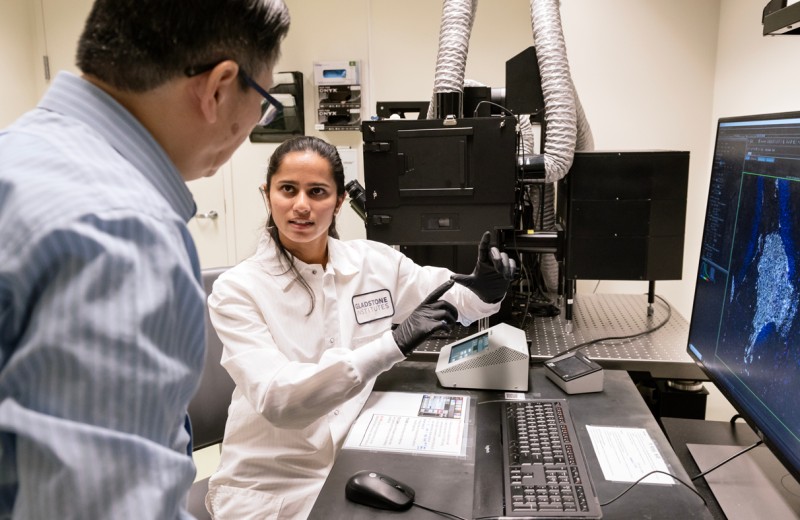Gladstone NOW: The Campaign Join Us on the Journey✕

Dr. Li Gan has made two major new discoveries about progranulin, a naturally occurring protein that causes frontotemporal dementia: low levels of the protein can contribute to Alzheimer's, and raising levels can block it. [Photo: Chris Goodfellow]
Researchers at the Gladstone Institutes have shown that low levels of the protein progranulin in the brain can increase the formation of amyloid-beta plaques (a hallmark of Alzheimer’s disease), cause neuroinflammation, and worsen memory deficits in a mouse model of this condition. Conversely, by using a gene therapy approach to elevate progranulin levels, scientists were able to prevent these abnormalities and block cell death in this model.
Progranulin deficiency is known to cause another neurodegenerative disorder, frontotemporal dementia (FTD), but its role in Alzheimer’s disease was previously unclear. Although the two conditions are similar, FTD is associated with greater injury to cells in the frontal cortex, causing behavioral and personality changes, whereas Alzheimer’s disease predominantly affects memory centers in the hippocampus and temporal cortex.
Earlier research showed that progranulin levels were elevated near plaques in the brains of patients with Alzheimer’s disease, but it was unknown whether this effect counteracted or exacerbated neurodegeneration. The new evidence, published today in Nature Medicine, shows that a reduction of the protein can severely aggravate symptoms, while increases in progranulin may be the brain’s attempt at fighting the inflammation associated with the disease.

Plaque accumulation with decreased progranulin in a mouse brain. [Image: S. Sakura Minami]
According to first author S. Sakura Minami, PhD, a postdoctoral fellow at the Gladstone Institutes, “This is the first study providing evidence for a protective role of progranulin in Alzheimer’s disease. Prior research had shown a link between Alzheimer’s and progranulin, but the nature of the association was unclear. Our study demonstrates that progranulin deficiency may promote Alzheimer’s disease, with decreased levels rendering the brain vulnerable to toxicity.”
In the study, the researchers manipulated several different mouse models of Alzheimer’s disease, genetically raising or lowering their progranulin levels. Reducing progranulin markedly increased amyloid-beta plaque deposits in the brain as well as memory impairments. Progranulin deficiency also triggered an over-active immune response in the brain, which can contribute to neurological disorders. In contrast, increasing progranulin levels via gene therapy effectively lowered amyloid beta levels, protecting against cell toxicity and reversing the cognitive deficits typically seen in these Alzheimer’s models.
These effects appear to be linked to progranulin’s involvement in phagocytosis, a type of cellular house-keeping whereby cells “eat” other dead cells, debris, and large molecules. Low levels of progranulin can impair this process, leading to increased amyloid beta deposition. Conversely, increasing progranulin levels enhanced phagocytosis, decreasing the plaque load and preventing neuron death.
“The profound protective effects of progranulin against both amyloid-beta deposits and cell toxicity have important therapeutic implications,” said senior author Li Gan, PhD, an associate investigator at Gladstone and associate professor of neurology at the University of California, San Francisco. “The next step will be to develop progranulin-enhancing approaches that can be used as potential novel treatments, not only for frontotemporal dementia, but also for Alzheimer’s disease.”
Machine Learning Reveals Behaviors Linked with Early Alzheimer’s, Points to New Treatments
Machine Learning Reveals Behaviors Linked with Early Alzheimer’s, Points to New Treatments
A team of Gladstone scientists used a new video-based tool to pinpoint otherwise-undetectable signs of early disease.
News Release Research (Publication) Alzheimer’s Disease Dementia Palop Lab AI Disease ModelsBrain Immune Cells Amplify Damage Caused by Alzheimer’s Risk Gene, Study Finds
Brain Immune Cells Amplify Damage Caused by Alzheimer’s Risk Gene, Study Finds
Transplanting human neurons into mouse brains reveals disease-causing interactions between the APOE4 protein and immune cells.
News Release Research (Publication) Alzheimer’s Disease Neurological Disease Huang LabA New Era of Treating Neurological Diseases at the Blood-Brain-Immune Interface
A New Era of Treating Neurological Diseases at the Blood-Brain-Immune Interface
Gladstone scientists say it’s time to think differently about how to define and treat diseases such as Alzheimer’s and multiple sclerosis.
News Release Research (Publication) Alzheimer’s Disease Dementia Multiple Sclerosis Parkinson’s Disease Neurological Disease Akassoglou Lab



